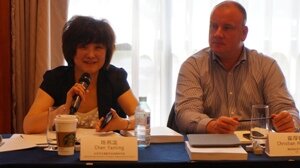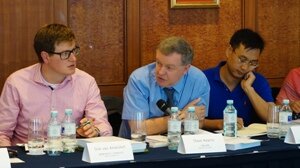 As a mega city with over 20 million people and 5 million motor vehicles shuttling the city, Beijing bears the brunt of traffic congestion and other constraints of urban development. It is imperative to integrate transport with city planning and environmental protection. Air pollution and congestion are two of the most urgent problems calling for attention.
As a mega city with over 20 million people and 5 million motor vehicles shuttling the city, Beijing bears the brunt of traffic congestion and other constraints of urban development. It is imperative to integrate transport with city planning and environmental protection. Air pollution and congestion are two of the most urgent problems calling for attention.
As a result, both an enhanced low emission zone in Beijing and congestion charging are being assessed as potential policy options. Often mentioned in the same breath, low emission zones and congestion charging schemes are in fact two very different policies with entirely different policy objectives. Whereas the primary aim of low emission zones is compliance with pollution standards (better air quality), the central aim of congestion charging is to reduce congestion and gain public revenue that can be reinvested in public transport systems.
At the moment, Beijing Transport Research Center (BTRC) commissioned by Beijing Municipal Commission of Transport, is doing intensive research to assess the effectiveness of different congestion charging schemes in reducing traffic congestion as well as GHG emission.
GIZ in cooperation with the Asian Development Bank currently facilitates a several week long stay of Dirk van Amelsfort, senior researcher at Viktoria Swedish ICT Research Center and congestion charging specialist to support BTRC in their work. Using Beijing’s PTV VISUM Travel Demand Model and the newly developed HBEFA-China emission model the emission impacts of different congestion charging schemes can now be calculated and compared. This will help decision makers to select the most effective approaches and policies. The model can also be used to measure and report emissions after implementation based on the same methodology.
Beijing Environmental Protection Bureau on the other hand has been analysing the effects of low emission zones, supported by Energy Foundation.
Against this backdrop, on August 12th 2014, GIZ and Energy Foundation jointly organized the workshop “Beijing Congestion Charging and Low Emission Zones Policy” in Beijing to bring together representatives of Beijing Commission of Transport and Beijing Environmental Protection Burea with international experts for an in-depth discussion and exchange on congestion charging and low emission zones.
 During the workshop, Steve Kearns from Transport for London introduced the congestion charging scheme and low emission zone policy in London. Afterwards Dirk van Amelsfort presented on the Swedish cities Stockholm and Gothenburg. Representatives from Beijing Transport Research Center and Beijing Vehicle Emission Management Center respectively introduced the current research stage of a potential congestion charging and updated low emission zone policy in Beijing. Together with experts from Beijing Municipal Commission of Transport, Beijing Municipal Environmental Protection Bureau participants discussed the feasibility of congestion charging versus different low emission zone approaches.
During the workshop, Steve Kearns from Transport for London introduced the congestion charging scheme and low emission zone policy in London. Afterwards Dirk van Amelsfort presented on the Swedish cities Stockholm and Gothenburg. Representatives from Beijing Transport Research Center and Beijing Vehicle Emission Management Center respectively introduced the current research stage of a potential congestion charging and updated low emission zone policy in Beijing. Together with experts from Beijing Municipal Commission of Transport, Beijing Municipal Environmental Protection Bureau participants discussed the feasibility of congestion charging versus different low emission zone approaches.
Another highlight of the event was the Energy Foundation’s release of their report “International Best Practice on Congestion Charging and Low Emission Zone”. This report reviewed and summarised international best practice from London, Stockholm, Singapore, Milan, New York and roadway charging in the United States. It provides many valuable lessons and experience for Beijing’s policy planning and implementation in the future. Download the report click here.
Please also see our new publication on Low Emission Zones:
This new fact sheet provides a glance at what is “low emission zone” and its environmental impact, combining with the introduction and evaluation of the best practices of low emission zones in London and Berlin, at the end this fact sheet analyzes the low emission zone policy in Beijing and indicates the ways of improvement (soon also available in Chinese).


